Michael's talk brings forward a number of thought provoking points, so if you would like to discuss any of them, please leave a comment down below.
I'm a 3rd year Earth Sciences student from UCL taking a break from my rocks to discuss the problems we as a planet face. In particular I shall be focusing on Nuclear Power and its potential role in addressing climate change. Throughout my blog I'll be analysing its pros and cons and determining whether I (and hopefully you) think it is the answer, or part of, to climate change.
Friday 23 December 2016
Nuclear Power - Is our Fear Jeopardising our Future?
This is just a small post to share a video of a talk by Michael Shellengerger; an environmental policy expert who has dabbled in a large area of climate change topics from the planetary boundary hypothesis, to carbon pricing and beyond. This talk discusses how the impact of declining nuclear energy production is having a negative effect on our overall 'clean' energy productions, while also looking at the public's perception of nuclear, and the barriers this presents for the future of nuclear energy and climate change.
Michael's talk brings forward a number of thought provoking points, so if you would like to discuss any of them, please leave a comment down below.
Michael's talk brings forward a number of thought provoking points, so if you would like to discuss any of them, please leave a comment down below.
Monday 12 December 2016
Nuclear Fusion - The Future of Nuclear Energy?
A month or so ago I talked about ‘the science behind a
nuclear power plant’ with a brief description of nuclear fission, which is the
process of splitting an atom into two smaller atoms and is the way we harness
nuclear energy for electricity at the moment. Today I’ll be talking about
nuclear fusion, which is seen by some scientists as the way forward for nuclear
power and part of the key to a greener future with near unlimited energy supply.
Nuclear fusion, in the way most people will know about it, is
the process that powers the sun and ultimately is responsible for all life as
we know it on this planet (ITER 2016). In the sun, hydrogen atoms are fused together a
number of times to produce a helium atom, and it is this fusing of atoms that
produces the energy.
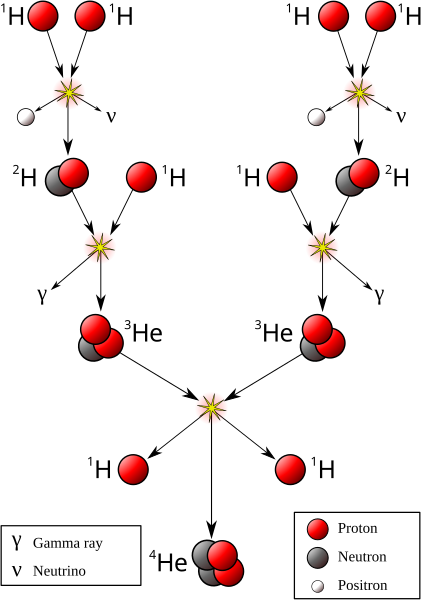 |
| Nuclear Fusion Process in the Sun (Wikipedia 2016) |
However on Earth, things have to be done slightly differently;
the nuclear fusion that occurs in the Sun begins at roughly 15 million °C, which
is pretty hot as you’d imagine (FusionForEnergy 2015). Sadly on Earth, we don’t have it as easy.
Due to the sheer size of the sun, it emits immense gravitational forces which
produce intense pressure as well as a high heat which allow it to carry out its
nuclear fusion (WNA 2016). On earth, we are not able to produce pressures on such a magnitude
so we have to compensate for this by increasing the temperature input to around
50 million °C (WNA 2016). The most efficient and feasible reaction scientists are able to
perform at the moment is a fusion of deuterium and tritium, which is essentially
two different heavy forms (isotopes) of hydrogen (HyperPhysics 2016). The tritium and deuterium are fused together
and a helium atom is created, with a neutron as a by-product; it is this
reaction that produces the energy. The aim is to get enough of these fusion
reactions to occur continuously that the process will be self-sufficient, and
more energy will be produced than is inputted. When this is achieved, nuclear
fusion will produce 4 times the energy yield of fission, and for every time
pressure within the reaction is doubled, the energy produced is increased
four-fold (WNA 2016) (MIT News 2016).
 |
| D-T Nuclear Fusion Process on Earth (AtomicArchive 2015) |
Now this is all sounds amazing, but there must be some
reasons why we aren’t doing this right now; and there are quite a few as you’d
imagine. First up is that extremely high temperature that is required to even
begin the reaction. This is needed to overcome the electrostatic forces that
act as a gateway to the fusion of the hydrogen atoms (WNA 2016). The issue isn’t creating
the temperatures, but creating a device that could contain such a reaction for
long periods of time. Without a long enough time period, the fusion reaction
wouldn’t be able to be self-sufficient and have a net-energy output (WNA 2016). Secondly
there is a slight issue of fuel; while the deuterium occurs naturally in
seawater (the deuterium in a gallon of seawater has the energy equivalent of
300 gallons of gasoline), the tritium is a bit harder to come by (HyperPhysics 2016). The tritium has
no sizeable natural source and due to its radioactivity, has a half-life of
around 12 years, which means it has to be bred from lithium; this could possibly
be a bottleneck in fuel supply (HyperPhysics 2016). Finally a big problem is the cost and scale it
is going to take to research and finally produce a workable reactor. Initial
costs of a fusion power plant are estimated to be around £10 billion, but the
research for it is even higher, with ITER (International Thermonuclear Experimental Reactor) the centre of nuclear fusion
experiments expecting to cost over €20 billion to even construct let alone run
the experiments (EUROfusion 2016) (Bloomberg 2016). As fusion reactions are in a gas form compared to fission
which occurs in a solid form, the energy released is less concentrated, so fusion
reactors will be bigger and more costly to build and maintain (WNA 2016).
 |
| ITER Construction Site (Science 2015) |
Other than the near unlimited energy that seems oh so far away,
are there any other positives? Well, like nuclear fission they would only have a
negligible contribution to greenhouse gas emissions if any and are seen as a
way to help reduce our CO2 emissions (WNA 2016). Unlike fission, fusion
reactors are easily shutdown and it would be near impossible for a Chernobyl or
Fukushima situation to occur (CCFE 2016). The issue of containing the reaction is also
seeing positive results, with magnetic fields which hold the plasma where the
reaction takes place being the preferred method (MIT News 2016). In terms of waste, no
long-lived radioactive products are produced and any unburnt gas is dealt with
on sight. There is the slight issue about the reactor structure itself
becoming radioactive due to long-term bombardment of high-energy neutrons, but
the radioactivity itself would be easily dealt with (WNA 2016). A big concern is a tritium
release into the surrounding environment, however this is hoped to be dealt
with by forgoing tritium altogether, and just fusing deuterium with deuterium
instead (WNA 2016).
 |
| Nuclear Fusion Reactor with Magnetic Field (FusionForEnergy 2015) |
Nuclear fusion is often seen as the finish line for nuclear
energy, and part of the end game in reaching our planet's energy needs. With
nuclear fusion experiments breaking previous records and devices containing the
reaction for longer periods of time and at higher pressures being built, it
seems we are edging closer to the goal (MIT News 2016). However, a long-running joke since the
70’s is that commercial nuclear fusion is always 40 years away, and as you can
probably guess, is the latest estimate for now as well (CCFE 2016). Perhaps nuclear fusion
is just one nut we’ll never be able to crack?
If you have any questions or are just curious about nuclear
fusion, don’t hesitate to leave a comment down below and I’ll get back to you
as quick as I can.
Monday 5 December 2016
Uranium Reserves – How much is there?
Uranium, as touched upon in a previous blog post, is the fuel used for nuclear fission and is primarily obtained through
mining. As an element in the Earth’s crust, uranium is a relatively common
metal on the scale of tin or zinc (Kidd 2011). Throughout the crust, uranium is
found in different concentrations known as ppm (parts per million), which is
how much of a certain rock is uranium. Rocks which have higher ppms will be
given a higher grade and will therefore be more economically viable to exploit.
The viability of the ore-body will also be dependent on the cost of energy
produced from other sources, as a higher energy cost would in turn make more ore-bodies
with lower ppms viable (WNA 2016).
Uranium can be found in various regions around the world,
although are highly concentrated in certain places, with the top 5 countries
having roughly 66% (OECD 2016) of known recoverable resources and just over 75% of
Uranium output (Mining-Tech. 2014). The top dog in terms of uranium resources by far is Australia,
with 29% of total known recoverable reserves, with Kazakhstan, Canada and
Russia each having a respectable 13-9% each (WNA 2016). This spread of uranium reserves
across the global and political landscape would mean it would be hard to truly
blockade a country from accessing uranium to feed its nuclear intent.
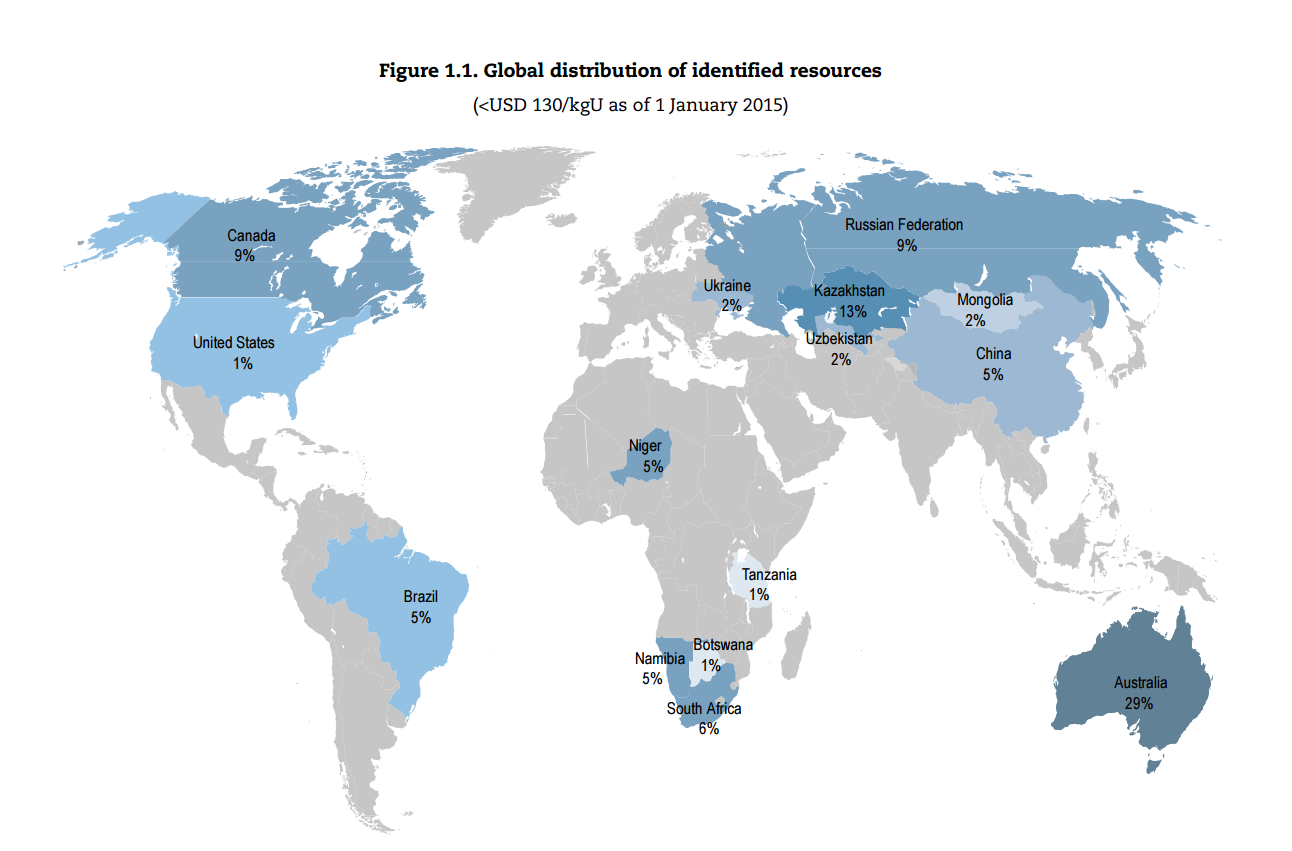 |
| Global distribution of Uranium in the top 15 countries (OECD 2016) |
 |
| Uranium per Country with Cost (WNA 2016) |
The big questions are how much uranium is there? And how long will the uranium last? This is mainly measured from the price of extracting said uranium, as some ore-bodies will cost more to extract. At a price of USD 130/kg and less, there is predicted to be 5.7 million tons of identified uranium that can be mined (OECD 2016), which if matched up with the 2006 uranium requirements of 66,500 tons, which would last roughly 85 years (Chmielewski 2008). Different sources using slightly different values calculate 80 years and 90 years of Uranium supply left at this price (Kidd 2011) (WNA 2016). These calculations are based on a scenario that nuclear energy doesn't really change going into the future, and a whole range of different scenarios could increase or decrease viable reserves. A decrease would only likely come about if the overall cost of producing energy decreased to a point, that nuclear energy was being priced out by other energy sources. If prices dropped to a point where only uranium mined at a price of USD 80/kg or less was viable, then only 37% of the 5.7 million tons mentioned earlier, would be able to be mined (OECD 2016). Increases of viable reserves could be caused by a number of things; simply an increase in the price of energy would allow more orebodies to be mined that were once too expensive. Discovery of further uranium resources from geological predictions will of course increase supply, with (Chmielewski 2008) estimating that we would have enough Uranium to last 300 years. Recycling plutonium from spent fuel cells could increase the life of today’s known uranium supply by 70 times, which would mean the reserves could last up 3000 years! Technological advances also have the capability to reduce mining costs and extend the life of fuel cells, with the new Generation-IV fast neutron reactors with their closed fuel cycle producing 100 times the energy with the same quantity of uranium (Chmielewski 2008). All these factors have the potential to come together, to give us the uranium we need for thousands of years.
 |
| Worldwide uranium resources and potential years of generation (Chmielewski 2008) |
Uranium resources have been increasing significantly since 1975 in correspondence to increased expenditure on exploration. This would suggest that as exploration increases, viable reserves of uranium would also increase, with previously uneconomic uranium from Florida once again being examined for possible extraction, and lower-grade ore bodies such as those in Morocco also being investigated (Kidd 2011). This is because, the uranium fuel only makes up a fraction of the cost of nuclear energy; only 2% of the cost is attributed to the uranium, with the vast majority attributed to building the plant, operating and maintenance. This means that a theoretical doubling of uranium prices would only add a 2% increase on to final electricity bills (Chmielewski 2008).
 |
| Known Uranium Resources, their prices and Exploration Expenditure (WNA 2016) |
As technology advances and additional orebodies become
viable and are discovered, it appears that reserves of uranium will be around
for thousands of years to come if managed correctly. This could pave the way to
an era of cleaner energy if managed correctly. This is dependent on the
research and exploration being done however, which may be at risk from
investment as recent discoveries of cheap shale have the potential to side-track
nations away from uranium exploration. Or there is the potential that uranium may
not be needed at all by 2050, with hopeful estimates that we could have nuclear
fusion power plants in operation by then!
Tuesday 29 November 2016
Public Opinion on Nuclear Energy
Nuclear energy has always been one of the most divisive
sources of energy; with support depending on the country, how well informed the
public are, and the events occurring around the world at the time. There are a
number of factors that influence the public such as nuclear waste, security,
cost of energy, reliance, safety, the media, climate change and many more.
Chernobyl
There isn’t much data on public opinion prior to the
Chernobyl disaster; but in a poll conducted by Harris in the US in 1975, 63%
supported building more nuclear power plants (Rosa et al., 1994). This dropped however, to 44% in
1979 after the Three Mile Island accident, and further still to 34% after
Chernobyl in 1986 (Rosa et al., 1994). However, the American public recognised nuclear energy as a
potential large scale energy source, as in a poll by Cambridge during the late 1980’s;
67%-78% said that nuclear energy was a good or realistic choice for the future (Rosa et al., 1994). In West
Germany, one of the closest Western nations to the Chernobyl disaster, polls
suggested around 15% supported a withdrawal from nuclear power prior to the
disaster; after the disaster, this rose to 37% the following year, and 65% the
year after that (Peters et al., 1990). It is noted however, that even after the Chernobyl disaster,
parties who supported withdrawing from nuclear power (along with public
opinion) didn’t have much, if any, increase in support in Germany’s parliamentary
elections the following year, suggesting that although there was a concern, nuclear
energy is not something at the forefront of the public minds.
After the Fukushima disaster in 2011, the German parliament
chose to phase out nuclear power (Dorothee et al., 2016). This was in direct contrast to a decision
made 6 months earlier to extend the nuclear power plant run-time. This would
mean that Fukushima had a direct effect on the decision of the German
parliament; but perhaps this was also influenced by the medias reporting? Prior to the
Fukushima disaster, Nuclear power was a dividing issue in Germany, with 43% in
support and 37% opposed. A few days after the accident, global support fell
from 57% to 49% which is to be suspected (Dorothee et al., 2016). News in Germany in the following year
also changed dramatically; with the economical (-21%) and energy aspects (-11%)
of nuclear energy seeing much less coverage, and on the other side, a large
increase in the coverage of the risks of nuclear (+23%) and the demonstrations (+12%)
against (Dorothee et al., 2016).
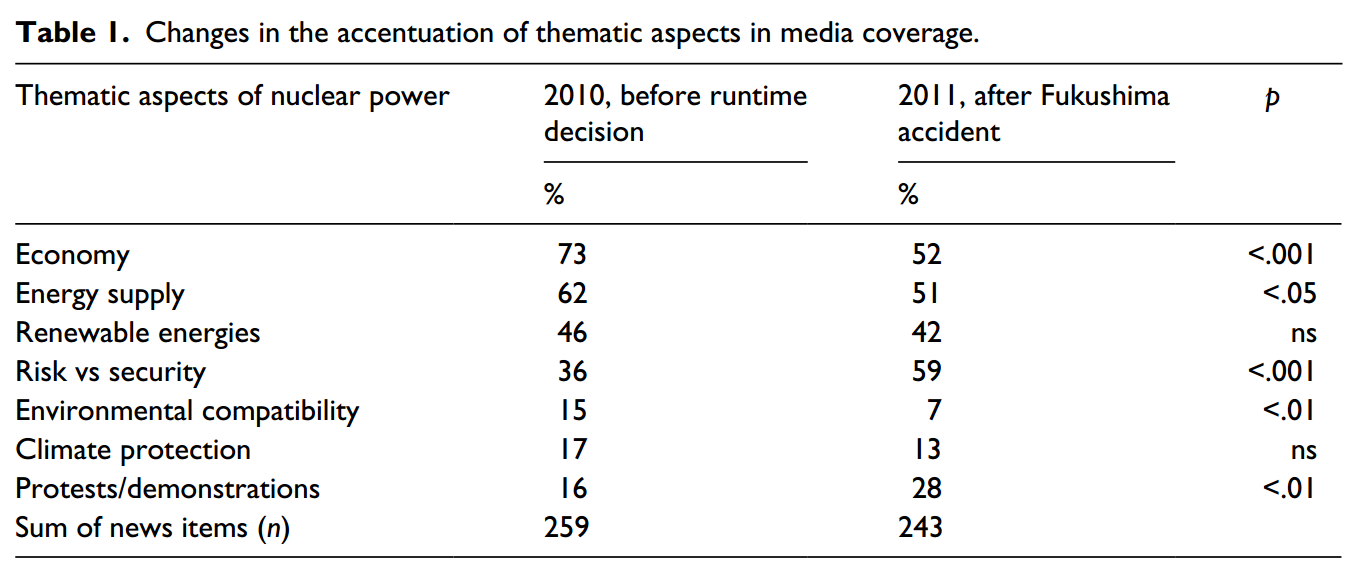 |
| Level of different themes represented in the news (Dorothee et al., 2016) |
Present
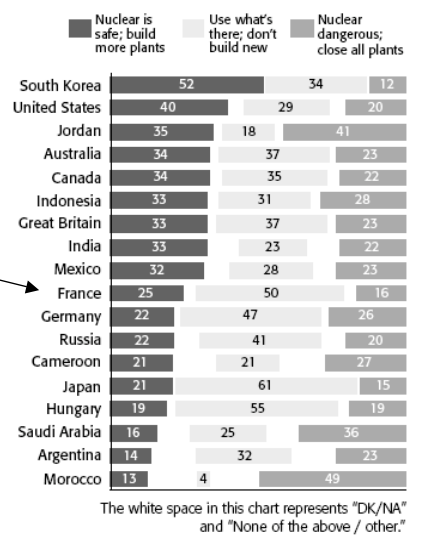 |
| Global public opinion on Nuclear Issues (Mycle Schneider 2009) |
Support is also dependent on the level of knowledge around the subject. When respondents were informed about the positive impacts of climate change, support for nuclear expansion increased on average by 10% (OECD 2010). This is mirrored in the US, with 60% either slightly opposing or slightly in favour of nuclear energy; when they feel very well informed, 54% are strongly in favour with another 22% somewhat in favour (Bisconti Research 2016). Even a moderate amount of knowledge on the subject, leads to a 77% in favour for nuclear energy.
 |
| (Bisconti Research 2016) |
In conclusion, support for nuclear energy has fluctuated
greatly over the years, in response to the disasters and development in the
world. Prices of fuel, level of education and even gender can have an effect on
support towards nuclear energy. What can be seen though is that when the advantages
are explained to people, especially involving climate change, the public are
much more willing to get behind the idea of nuclear energy; it just depends if they think those benefits outweigh the risks.
Wednesday 23 November 2016
Nuclear power in France: A Success Story?
In my last couple of blog posts, I’ve been talking about
when Nuclear energy goes wrong. But it is important to remember that Nuclear
energy does have its successes. In one place this is evident is France, which
produces the largest amount of nuclear energy as a percentage of its total
electricity production compared to any of country in the world; around 70-80% depending
on France’s electricity demand for the day (Philip Ball 2011). In 2007, France had the second largest
EU population of 63 million, the world’s 7th largest GDP, and 8th
largest energy consumption, while still providing 47% of all nuclear energy in
the EU (Mycle Schneider 2009). Hopefully this gives you a picture of the scale of France’s nuclear
power programme.
 |
| Nuclear share of total energy generation (Adamantiades et al. 2009) |
Why and How
In 1973, an oil crisis occurred caused by an embargo by the
members of OAPEC (Organisation of Arab Petroleum Exporting Countries) due to
American involvement in the Middle East (no surprise there). This led to France’s
president at the time, Pierre Messmer, to release a plan in 1974 to gain energy
independence for France through Nuclear power (WNA 2016). This led to a large scale
nuclear power project which was envisioned to produce 170 nuclear power
stations by 2000 (Sezin Topçu 2007); while the number of stations was only 58 in 2011 (Philip Ball 2011), the
efficiency of their energy production makes up for the lower amount. The rise
in nuclear power was backed with at least 75% of all public research and
development expenditures for energy being used for nuclear fission between 1985
and 2001 (Mycle Schneider 2009).
As France is relatively low in energy resources apart from
coal that is out-priced by cheap imports (Philip Ball 2011), Nuclear energy was one of the only
viable options that could give France the energy independence it desires. Other
advantages of nuclear over coal is the fuel used; Uranium doesn’t degrade over
time while coal does, It has 1/10 the cost of coal in terms of equivalent
energy produced, and is 4 magnitudes (104) smaller than coal in terms
of equivalent energy (Adamantiades et al. 2009) .
From the outset, the French Government chose to reprocess
used fuel to re-cover uranium and plutonium, to help reduce the amount of
high-level waste that needs disposal. This has led to 20% of all the electricity
produced by EDF (Electricte de France) to come from recycled fuel (Philip Ball 2011). For the disposal of final waste,
France is planning on opening a deep geological repository for a permanent
solution. Research at its facility in Bure, has confirmed the rocks suitability
to the task and should this go ahead, it could store all of France’s current
nuclear waste, and that created in the coming 20 years from its completion (Declan Butler 2010).
Is it a true success?
 |
| Final energy supply in France in 2007 (Mycle Schneider 2009) |
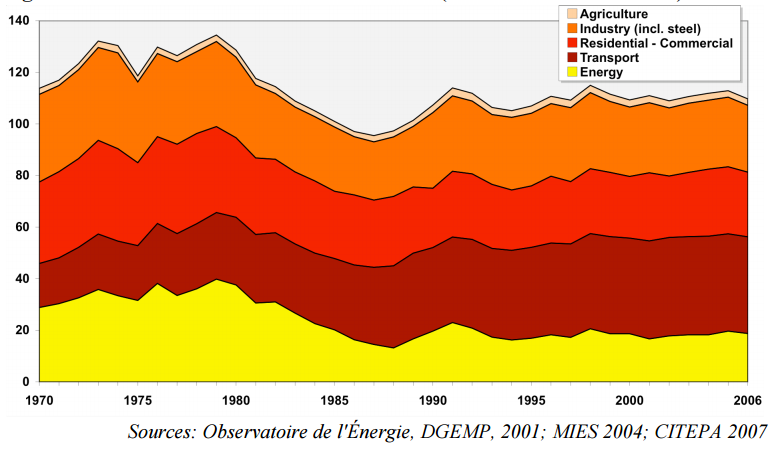 |
| CO2 Emissions from France in 1970-2006 (Mycle Schneider 2009) |
France’s story makes me wonder, that for how far France has come in terms of nuclear energy, it has a long way to go if it wants to be energy independent and for nuclear energy to be a big part of that. But is it possible for a country to be powered solely by nuclear? Can all the processes be powered by nuclear that are now driven by fossil fuels? Electric powered cars are available now, but larger costs and reduced range stops them from becoming the main source of transport. Perhaps the technology is not where it needs to be, for nuclear power to become the large force in energy production it could be.
Monday 14 November 2016
Fukushima - A Nuclear Disaster II
Today will just be a quick blog on the second disaster to score a 7 on the International nuclear and Radiological Event Scale, the Fukushima Disaster (WNA 2016). The result of the damage caused by a 15-metre tsunami following a major earthquake of magnitude 9.0 on Japans East Coast; this disaster has forced around 154,000 people to be evacuated from their home with no real knowledge of when, or if, they will be able to return (Reconstruction Agency).
The first video is slightly technical, but it is a very good explanation of the events that unfolded from an objective point of view. It explains how this particular nuclear reactor works, which in turn will allow a better understanding of why the reactors went into meltdown and the path it followed.
The second video is produced by Greenpeace and looks at the impacts that the radiation has had on the environment and the local population. As Greenpeace is a noted activist against nuclear power, it is good to keep in mind that this video will most likely contain some bias against nuclear power which may or may not be true (Greenpeace).
If you are really interested in the details of the Fukushima Disaster, I'd recommend taking a look at this web page by the World Nuclear Association; it contains a good summary with lots of detailed subsections for you to investigate depending on your interest.
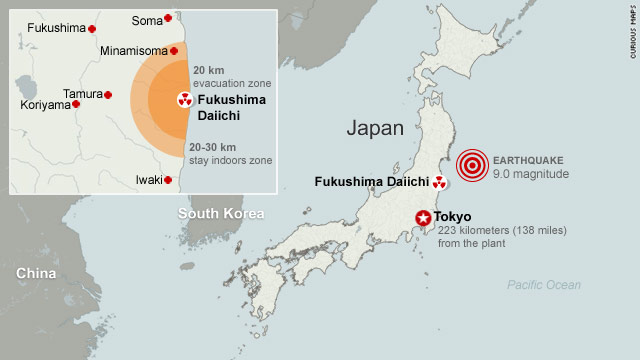 |
| Location of the Fukushima power plant and evacuation zones (CNN 2011) |
The first video is slightly technical, but it is a very good explanation of the events that unfolded from an objective point of view. It explains how this particular nuclear reactor works, which in turn will allow a better understanding of why the reactors went into meltdown and the path it followed.
The second video is produced by Greenpeace and looks at the impacts that the radiation has had on the environment and the local population. As Greenpeace is a noted activist against nuclear power, it is good to keep in mind that this video will most likely contain some bias against nuclear power which may or may not be true (Greenpeace).
If you have a bit more time to spare and want to watch a documentary style video of the disaster such as those on TV, here is another option.
If you are really interested in the details of the Fukushima Disaster, I'd recommend taking a look at this web page by the World Nuclear Association; it contains a good summary with lots of detailed subsections for you to investigate depending on your interest.
Tuesday 8 November 2016
Chernobyl - A Nuclear Disaster
When nuclear power is mentioned in a conversation, the
Chernobyl disaster is often one of the topics quickly brought up, and for good
reason; it is one of only two disasters, alongside Fukushima, to score a 7 (the
highest) on the International nuclear and Radiological Event Scale (PIF).
I shall quickly summarise the causes of the disaster and then look into its impacts.
 |
| International Nuclear and Radiological Event Scale (IAEA) |
Causes
On the 25th April 1986, the crew at Chernobyl
reactor 4 began arrangements for a test that would run the plant at a very low
power, to determine how long the turbines would carry on spinning and supplying
energy to the water circulating pumps after a loss of power (WNA 2016). The design of these
reactors was such that they were highly unstable at the low power that this
test would operate at, mainly due to accelerated nuclear chain reaction and
power output if the cooling water for the reactors was lost. For the test to be
carried out, the automatic shutdown mechanisms also had to be disabled, which
did not comply with operational procedures; however, the operators had not even
been informed of the possible explosive consequences of the test they were
about to perform (WNA). These factors all
combined to put the reactor in a very unstable condition before the test had
even started.
 |
| Location of Chernobyl in Ukraine (Wordpress) |
The test began in the early morning of the 26th,
with the inserting of control rods into the reactor creating a large power surge
that created a large increase in heat (NEI 2015). The hot fuel interacted with the cooling
water to rapidly create steam which in turn increased the pressure. This increase
of pressure partially removed the 1000 ton cover off the top of the reactor,
jamming the half-inserted control rods, and rupturing the fuel channels (WNA 2016). The
steam generation spread throughout the rest of the core and created a steam
explosion, which released the radioactive fission products into the atmosphere.
The Chernobyl power plant lacked the containment structure that is seen in most
nuclear power plants around the world. Without this, the radioactive fission products
were free to escape into the atmosphere (NEI 2015).
Impacts
Soviet scientists reported that between 13% and 30% of the
192 tonnes of fuel was released into the atmosphere for a period of roughly 10
days (NEI 2015). The main problematic radioactive materials released were the short-lived Iodine-131
with a half-life of 8 days; and the longer lived Caesium-137 with a half-life
of roughly 30 years (WNA 2016) (A half-life being the amount of time it takes for the
amount of material to decrease(decay) by half). Substantial amounts of
radioactive material were deposited in North-West Ukraine, Belarus and parts of
Russia, with Belarus receiving 60% of contamination that fell on the Soviet
Union (NEI 2015). This resulted in the resettlement of civilians over the years, with 116,000
resettled by the summer of 1986, and a further 230,000 in the coming years (UNSCEAR 2008).
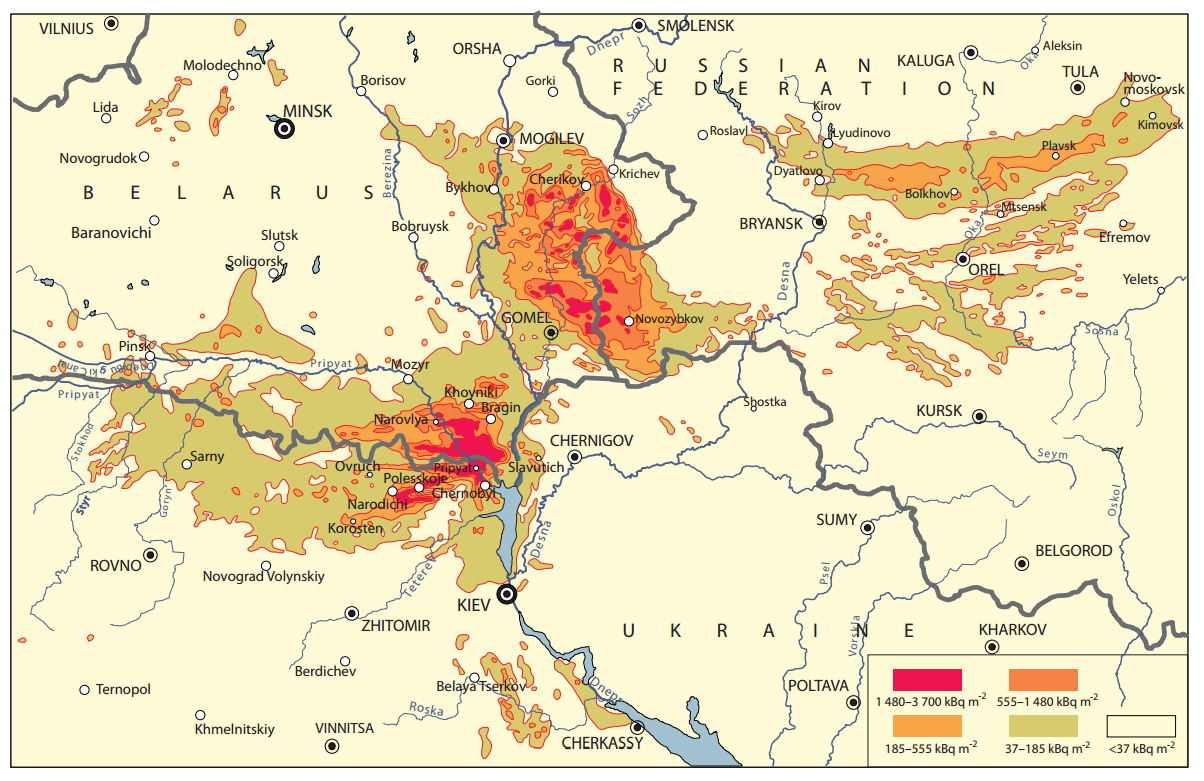 |
| Map of Caesium-137 deposition levels as of December 1989 (UNSCEAR 2008) |
Around 350,000 clean-up workers, or liquidators, were brought in to help contain and clean up the radioactive debris during the following two years after the disaster. 240,000 of these liquidators received the highest radiation doses while working within the 30km zone around the reactor (WHO 2006). 134 liquidators received doses even higher and were diagnosed with acute radiation sickness (ARS), with 28 workers dying in 1986 due to this (UNSCEAR 2008). In the table below, you can see that the level of radiation that populations received following the disaster is actually quite low and comparable to natural background levels. It is estimated that in the top three exposed populations, Liquidators, Evacuees and Residents of the SCZs, cancer deaths from radiation exposure has only increased 3-4% above the norm; while in the residents with low contamination, it has potentially only risen 0.6%
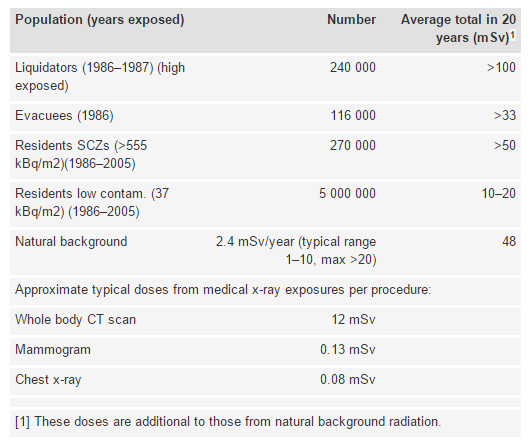 |
| Average radioactive dose accumulated over 20 years (WHO 2006) |
There was a large increase in thyroid cancer following the disaster in those exposed as children or adolescents (>14 years old) (UNSCEAR 2008). This was due to the release of radioactive iodine which was then taken up into the thyroid. This was not the result of direct exposure however, poor management in the following weeks meant milk was consumed from cows that had pastured in iodine contaminated fields. Radioactive iodine became concentrated in their milk, which when drank by children with preexisting iodine deficiencies, caused the iodine to accumulate in the thyroid at greater concentrations (WHO 2006). If milk had been brought in from elsewhere, a lot of the radiation-induced thyroid cancer could have been avoided. The prognosis for thyroid cancer is very good however, with treatment being highly effective even in advanced stages (WHO 2006).The graph below shows that as Iodine has a low half-life, thyroid cancer was only prevalent in children under the age of 10 at the time of the incident and has not affected those born after the disaster.
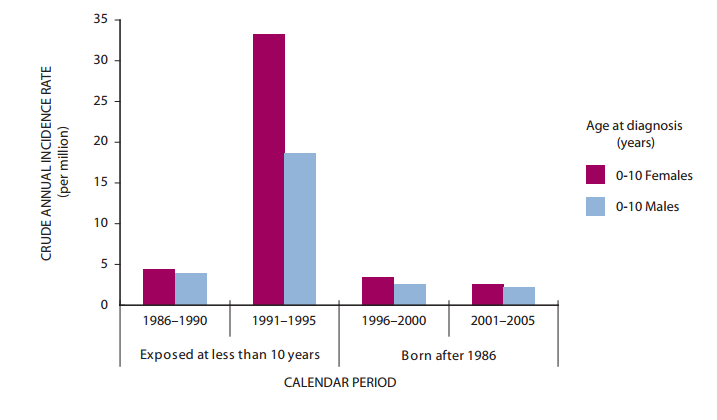 |
| Thyroid cancer incidence rate in Belarus for children under 10 years old at diagnosis (UNSCEAR 2008) |
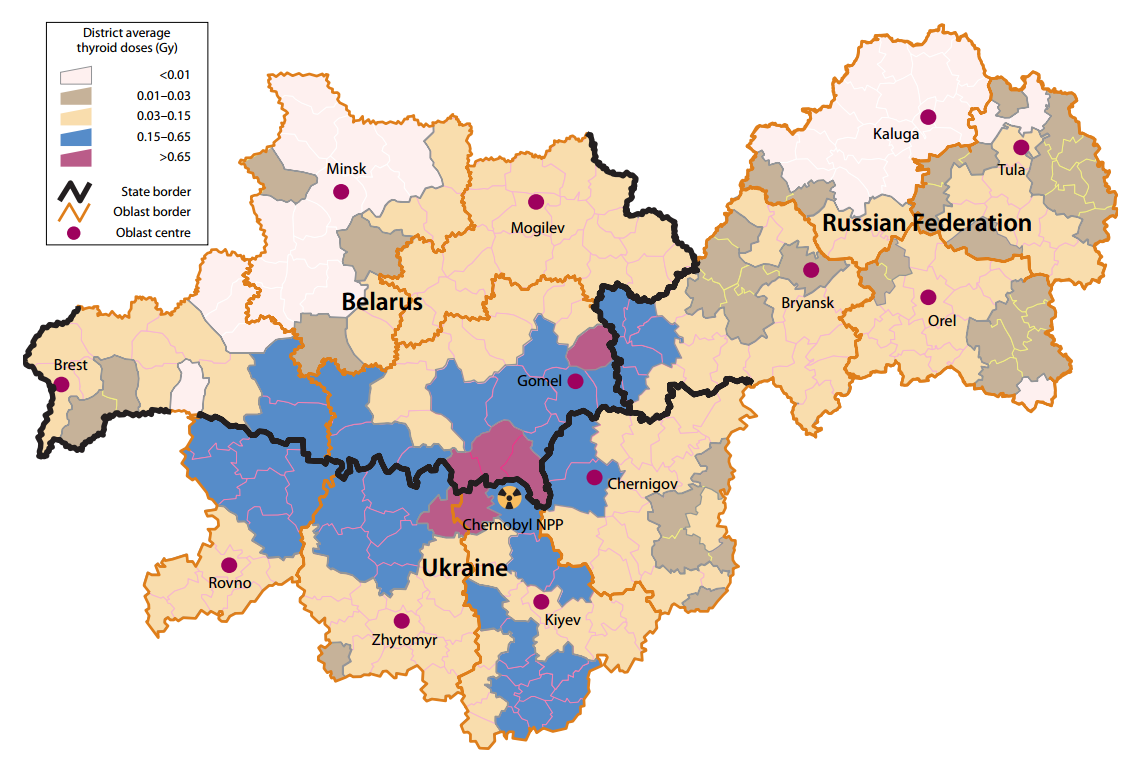 |
| Estimated average thyroid doses to children and adolescents living at the time of the accident (UNSCEAR 2008) |
Overall the Chernobyl disaster has had a massive effect on the local human population and the local environment, clearly showing the extreme negative effects that a nuclear disaster could have with a 4300km2 exclusion zone now in place around the old reactor (WNA 2016). Also needing to be factored in is the continued maintenance of the structure that houses the old reactor to prevent further radioactive leaks. However studies done at the time seem to have overestimated the effects that radiation would have on its immediate surroundings. Recent studies have shown that deaths from the resulting radiation are much lower than they had anticipated, and that the environment inside the exclusion zone is in fact thriving, with a much greater biodiversity and abundance of species than before (WNA 2016). Perhaps this disaster was not as bad as we once thought?
Friday 28 October 2016
The Science Behind a Nuclear Power Plant
The process that powers a nuclear power plant is nuclear fission.
While nuclear fusion is the process of fusing two or more lighter elements into
a larger one, such as that which happens in stars; nuclear fission is the
splitting of a large atom into two or more smaller atoms (Diffen). Although nuclear fusion produces a larger
amount of energy than fission, we do not currently have the technology to
overcome the barriers needed to attain it.
 |
| Nuclear Fission vs Nuclear Fusion (Duke Energy) |
While this topic may be quite new for some readers, I sadly
don’t have enough space to explain properly some of the elements I’ll
be discussing. If you want to know the basics about atoms and isotopes, or
would just like a small refresher click this link and check out the different
pages.
In a nuclear reactor, an element called Uranium is used as
the fuel. This element has a number of isotopes, with an isotope being the same
element, but with a different number of neutrons. Nuclear fuel consists of the isotopes U-238
and U-235, with the U-235 being the fissionable isotope. In the nuclear reactor,
neutrons are fired at the U-235 which make it become U-236 as the number of
neutrons have changed (NEI 2016). This makes the uranium unstable and causes it to split
apart into two new atoms and three neutrons, while also releasing the energy
that we collect. The three released neutrons can then split more uranium, which
in turn release more neutrons and so on. This creates a chain reaction which is
now self-sufficient and will carry on until the fuel is spent (WNA 2016). If you find any
of this confusing, check out the first page of this link which will hopefully
clarify any issues, or post a comment down below.
 |
| Nuclear Fission involving U-235 (BBC Bitesize) |
Now that all the nuclear science is out of the way, the rest
of a nuclear power plant is practically the same as a conventional plant that
burns coal, oil and natural gas. Energy from the reaction, which in our case is
the splitting of U-235, is used to heat up water to its boiling point which is
where it would normally be converted into steam (Darvill 2016). However, the pipes that
contain the water are pressurised, so the water stays in its liquid form. This
water is transported through another tank called a steam generator which
contains water under lower pressure. The heat is then transferred from
the heated water in the pipes to the water in the steam generator which boils
into steam as it is under lower pressure (Darvill 2016). This steam then turns a turbine which
turns a generator which then produces the electricity that we all know and
love. The steam is then condensed back
into water and returns to the steam generator to repeat the process. This can all be a bit much too follow, so
below is a gif showing the overall process and also a small video with an
explanation.
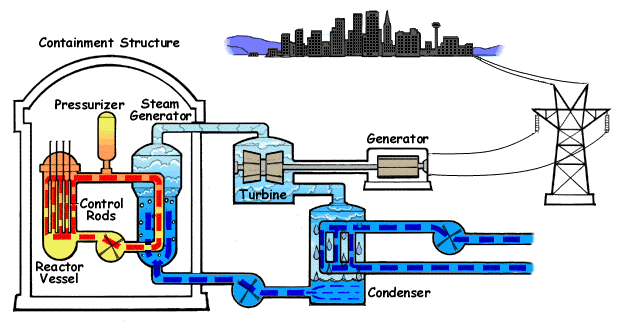 |
| Nuclear Reactor Diagram (What is Nuclear) |
In the following weeks I shall be discussing success stories and disaster incidents of nuclear energy, starting with the Chernobyl disaster. If you have any questions about
today’s post, please do not hesitate to ask in the comments below, and I shall answer to
the best of my ability. I’ll also leave a video down below; it gives a brief
history of nuclear energy, its processes and has follow on videos of its pros
and cons that can be found at its end as well.
Friday 21 October 2016
Nuclear Power as an Energy Source in the Modern World
The world as we
know it is going through an energy and climate crisis and no one seems to have
a convincing argument of what to do. How long will conventional fossil fuels
last? Will renewable energy be able to plug the energy gap? How much of an
impact will fossil fuels have on the planet? When people talk about energy
production for the future, you always hear about wind, solar, and often a new
exploitation of fossil fuels, which for now is the fracking of shale gas. But
often not nuclear energy, which gets me thinking; why is nuclear energy
ignored?
Over the course of
the coming months through this blog, I shall be exploring the potential of nuclear
energy as an answer to our energy and climate crisis. Nuclear energy often goes
unmentioned in the news, unless something goes wrong. This has the potential to
create a negative stigma towards a theoretically lucrative energy source.
However, when nuclear power stations go wrong, they go badly wrong, with
disasters such as Chernobyl and Fukushima coming to mind. Perhaps the negative
reputation is well deserved? Or perhaps it is just a lack of proper public
awareness of nuclear power?
I
will be writing this blog from a neutral standpoint; as someone who
doesn’t really know the complete story about nuclear energy and is curious of
its potential benefits, along with the associated risks that come with it. In
secondary school, energy sources was a hotly contested issue in Geography
lessons with renewables vs fossil fuels being the majority of the discussion.
This has always made me think, what is wrong with nuclear power? Fossil fuels
use has increased linearly over the last few decades, with China’s and India’s
recently increased development of power grid infrastructure and vehicular usage
adding a recent surge since the year 2000. An increase of a particularly dirty fossil fuel, coal,
is seen; with it contributing a larger percentage of primary energy supply in
2014 (28.6%) compared to 1973 (24.5%). In the same time period, renewable
energy has increased only 1.3% (IEA - Key World Energy Statistics 2016).
 |
| Graph of World Energy Consumption (IEA - Key World Energy Statistics 2016) |
It
seems to me, that we are reaching a point where not exploring nuclear power as
a bigger source of energy will cause detrimental effects to our environment and
climate. Greenhouse gases have been rising steadily since fossil fuel burning
began in earnest and on May 9th 2013, CO₂ levels passed 400 ppm for the first time in
recorded history (NASA 2013). As a proclaimed low-carbon source of energy (niauk), maybe nuclear
power is the answer we’ve been looking for?
To see whether it
is the answer that we, as a world are looking for; I shall be researching and
discussing a number of topics, weighing up both sides of the arguments and
hopefully, by the end, reaching a conclusion that will have convinced you, as
well as myself, either for or against nuclear power.
A brief overview of topics, case studies and
questions (not a definitive list by any means) I aim to look at are below:
- What is Nuclear Fission?
- Nuclear energy use and its contribution to Climate Change
- The safety of nuclear energy
- Nuclear Disasters – Chernobyl and Fukushima
- Nuclear Success Stories – France
- Nuclear Fusion and the future of nuclear energy
My next post will
be about the processes that occur within a nuclear power plant. I’ll be briefly
discussing the fuel used and then the overall process of Nuclear Fission, which
is the driving force behind a nuclear power plant. Do not fear about it being
overly complicated! As someone who hasn’t touched Physics since GCSE, my aim is
to make the explanation as simple as possible, leaving the complicated nuclear
physics to the experts.
If you have any comments, questions or
suggestions on topics, don’t hesitate to ask down below!
Subscribe to:
Posts (Atom)
